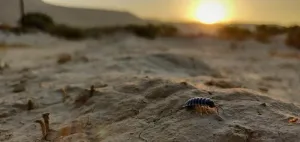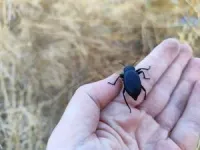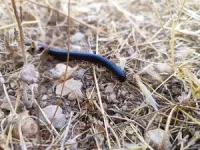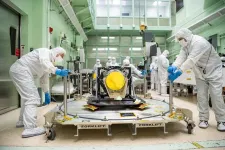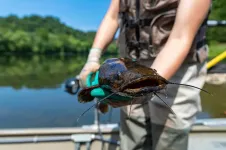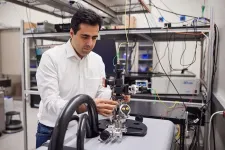(Press-News.org) New study reveals that in arid ecosystems, larger arthropods such as termites and beetles play a crucial role in decomposition, challenging the traditional view that microbial activity dominates this process in dry environments. By demonstrating that macro-decomposition can peak during the summer in arid sites and that overall decomposition rates in these regions can be similar to or even exceed those in wetter climates, the research provides new insights into how decomposition functions in drylands and its implications for global carbon cycling and ecosystem management.
Link to pictures: https://drive.google.com/drive/folders/19a7FbAw4DvYeg5_GdvFJzc6p-0gMuBqp?usp=sharing
Researchers from The Hebrew University of Jerusalem have discovered a potential solution to the long-standing "desert decomposition conundrum" in a new study in eLife. Led by Dr. Viraj Torsekar, Dr. Nevo Sagi and Professor Dror Hawlena from Hebrew University, the study challenges conventional beliefs about decomposition processes across different climate gradients. Traditionally, it was thought that decomposition rates were primarily driven by microorganisms and would decrease in drier environments. However, this new research uncovers that larger arthropods play a crucial and previously underappreciated role in arid ecosystems.
Key Findings:
Decomposers of different sizes respond distinctively to precipitation levels.
Microbial decomposition increases with precipitation during winter months.
Macro-decomposition, driven by larger arthropods such as termites and beetles, peaks in arid sites during the summer.
These contrasting responses result in similar overall decomposition rates across most of the precipitation gradient.
The researchers conducted their study across seven sites in Israel, ranging from hyper-arid to Mediterranean climates. They utilized innovative litter baskets with varying mesh sizes to isolate the effects of different-sized decomposers.
"Our findings show that the contrasting climate dependencies of micro- and macro-fauna decomposers lead to unexpectedly high decomposition rates in arid environments," says Dr. Torsekar. "This provides a plausible explanation for why plant litter decomposition in drylands occurs faster than previously thought—a puzzle that has challenged scientists for decades."
"This research highlights the overlooked role of larger arthropods in dry ecosystems," adds Dr. Sagi. "By revealing that arid regions can support decomposition rates similar to or higher than wetter areas, we hope to inspire new strategies for conserving these vulnerable ecosystems."
Professor Hawlena concludes, "Understanding the dynamics of decomposition in drylands is essential for conserving and restoring critical ecosystem processes, particularly as these regions expand globally. Our findings also have significant implications for global carbon cycling and climate change models."
The study's implications reach beyond ecology, potentially influencing climate change models and conservation strategies for arid ecosystems worldwide.
END
New study reveals larger insects' critical role in decomposition in arid ecosystems
2024-10-22
ELSE PRESS RELEASES FROM THIS DATE:
NASA reveals prototype telescope for gravitational wave observatory
2024-10-22
NASA has revealed the first look at a full-scale prototype for six telescopes that will enable, in the next decade, the space-based detection of gravitational waves — ripples in space-time caused by merging black holes and other cosmic sources.
The LISA (Laser Interferometer Space Antenna) mission is led by ESA (European Space Agency) in partnership with NASA to detect gravitational waves by using lasers to measure precise distances — down to picometers, or trillionths of a meter — between a trio of spacecraft distributed in a vast configuration larger than the Sun. Each side of the triangular array ...
A new kind of authoritarianism: Democracy in decline at home and abroad
2024-10-22
A majority of Americans worry this year’s general election will be tainted by fraud, according to a recent NPR/PBS News/Marist poll released earlier this month—an ominous indication of the state of democracy in the U.S.
“When citizens lose trust in the electoral process, they may question the legitimacy of elected officials and the institutions they represent, which undermines the foundational principle that government authority is derived from the will of the people,” ...
Performance in physical tests can help manage treatment for metastatic lung cancer
2024-10-22
A study of patients with metastatic lung cancer by researchers based in Brazil and the United States has found that their performance in simple physical tests such as sitting down, standing and walking can help physicians arrive at a prognosis and approach to treatment.
An article on the study is published in the European Journal of Clinical Investigation.
The findings also included identification in the volunteers’ blood plasma of two substances – serine and M22G – with the potential to become biomarkers capable of indicating which patients are most likely to respond to chemotherapy.
The study was supported by FAPESP (projects 16/20187-6 and 19/17009-7), ...
Expanding access to weight-loss drugs could save thousands of lives a year
2024-10-22
New Haven, Conn. — Expanding access to new, highly effective weight-loss medications could prevent more than 40,000 deaths a year in the United States, according to a new study led by researchers at Yale School of Public Health and the University of Florida.
The findings highlight the critical need to remove existing barriers that are hindering people’s access to effective weight loss treatments and impeding public health efforts to address the national obesity crisis, the researchers said. According to the U.S. Centers for Disease Control and Prevention, about 74% of Americans are considered overweight, with about 43% of those individuals ...
Harnessing science to tackle global crises
2024-10-22
In a paper published in PLOS Sustainability and Transformation, an international team of researchers looked at how science could play a more active role in managing crises. The paper builds on the outcomes of the international conference “What Role for Science in Crisis Times? Outlook in the Health, Environment, and Agriculture Interconnected Areas”, held in Montpellier in 2022.
To enhance science’s contribution to crisis management, the paper emphasises the need for interdisciplinarity, where science is integrated across disciplines, and transdisciplinarity, which incorporates various societal actors and stakeholders. By co-designing and co-producing ...
Caltech's new fingerprint mass spectrometry method paves the way to solving the proteome
2024-10-22
Caltech scientists have developed a method driven by machine learning that allows them to accurately measure the mass of individual particles and molecules using complex nanoscale devices. The new technique opens the possibility of using a variety of devices for the measurement of mass and, therefore, the identification of proteins, and could pave the way to determining the sequence of the complete proteome, the collection of all the proteins in an organism.
Proteins are the engines of living systems. Which proteins are made, ...
Invasive flathead catfish impacting Susquehanna’s food chain, researchers find
2024-10-22
UNIVERSITY PARK, Pa. — Flathead catfish — native to the Mississippi River basin — were first detected in the Susquehanna River in Pennsylvania in 2002, according to the U.S. Geological Survey. In the two decades since then, the invasive species has spread throughout the river basin. The impact of the large predator on the waterway’s food webs and ecology was unknown, but now a research team is beginning to understand what Susquehanna flatheads are eating and how their presence is affecting native aquatic species in the river.
The findings, which the team said state ...
Javadi receives DOE Early Career Award to study qubit hosts
2024-10-22
NORMAN, OKLA. – Alisa Javadi, Ph.D., professor at the University of Oklahoma School of Electrical and Computer Engineering and the Homer L. Dodge Department of Physics and Astronomy, has received funding from the U.S. Department of Energy Early Career Research Program for research that offers the potential for advancing quantum technology development.
Javadi’s research will test the use of cerium oxide as a host for quantum bits, or qubits. Qubits, the building blocks of quantum computing, need an environment free ...
Obesity Medicine Fellowship created at Pennington Biomedical
2024-10-22
Obesity Medicine Fellowship Created at Pennington Biomedical
Fellowship product of collaboration between Pennington Biomedical Research Center’s Metamor Clinic and Louisiana State University Health New Orleans School of Medicine
FOR IMMEDIATE RELEASE
Oct. 22, 2024
BATON ROUGE – A new Obesity Medicine Fellowship at Pennington Biomedical Research Center is now open for candidate applications. The one-year program is the result of a collaboration between Pennington Biomedical and Louisiana State University Health ...
Structural biology analysis of a Pseudomonas bacterial virus reveals a genome ejection motor
2024-10-22
BIRMINGHAM, Ala. – The viruses that infect bacteria are the most abundant biological entities on the planet. For example, a recent simple study of 92 showerheads and 36 toothbrushes from American bathrooms found more than 600 types of bacterial viruses, commonly called bacteriophages or phages. A teaspoon of coastal seawater has about 50 million phages.
While largely unnoticed, phages do not harm humans. On the contrary, these viruses are gaining increasing popularity as biomedicines to eradicate pathogenic ...
